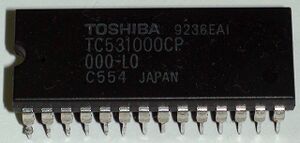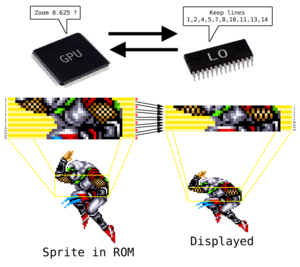L0 ROM: Difference between revisions
mNo edit summary |
m (BIOS -> system ROM) |
||
| Line 5: | Line 5: | ||
"L" probably stands for "Lookup". It's a 64KiB (sometimes 128KiB with A16 tied to ground) ROM chip found in every NeoGeo systems, which contains byte values used by [[LSPC]] to shrink [[sprites]] vertically. | "L" probably stands for "Lookup". It's a 64KiB (sometimes 128KiB with A16 tied to ground) ROM chip found in every NeoGeo systems, which contains byte values used by [[LSPC]] to shrink [[sprites]] vertically. | ||
The dump is often called 000-lo.lo in [[ | The dump is often called 000-lo.lo in [[System ROM]] sets. | ||
==Data== | ==Data== | ||
Revision as of 06:38, 28 October 2015


"L" probably stands for "Lookup". It's a 64KiB (sometimes 128KiB with A16 tied to ground) ROM chip found in every NeoGeo systems, which contains byte values used by LSPC to shrink sprites vertically.
The dump is often called 000-lo.lo in System ROM sets.
Data
The data contained in this ROM is actually 256 tables of 256 bytes, each table corresponding to a value of the vertical shrinking for sprites.
For the first 256 lines (first half of a full sprite), the index in the table is the horizontal line number of the sprite currently being drawn (scanline - Y position).
Each byte is used as 2 nibbles:
- The upper nibble is the tile number index to read in the tilemap table in VRAM SCB1 (0 to 15).
- The lower nibble is the line number of that tile to fetch in the C ROMs.
For the last 256 lines (second half of a full sprite), the index in the table is 255-((scanline - Y position) & 255). The table is read backwards.
Each byte is used as 2 nibbles:
- The upper nibble is the tile number index XOR $1F to read in the tilemap table in VRAM SCB1 (0 to 15).
- The lower nibble is the line number XOR $F of that tile to fetch in the C ROMs.
Example of GPU processing
(Maybe place this part in the GPU page ?)
Sprite with Y zoom value = $1B and tile height = 2 (32 pixels).
- Line 0 of sprite. GPU asks LO data at address $1B00. Data is $00: Tilemap index 0, line 0 of tile.
- Line 1 of sprite. GPU asks LO data at address $1B01. Data is $08: Tilemap index 0, line 8 of tile.
- Line 2 of sprite. GPU asks LO data at address $1B02. Data is $10: Tilemap index 1, line 0 of tile.
...
- Line 26 of sprite. GPU asks LO data at address $1B1A. Data is $E8: Tilemap index is $E, line 8 of tile.
- Line 27 of sprite. GPU asks LO data at address $1B1B. Data is $F8: Tilemap index is $F, line 8 of tile.
- Line 28 of sprite. GPU asks LO data at address $1B1C. Data is $FF: Tilemap index is $F, line $F of tile.
- Line 29 of sprite. GPU asks LO data at address $1B1D. Data is $FF: Tilemap index is $F, line $F of tile.
...
Datasheet
Official TC531001 datasheet: [[1]]